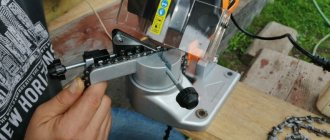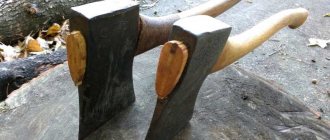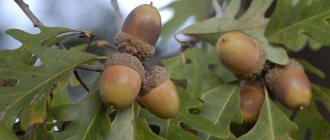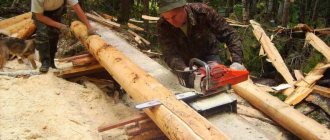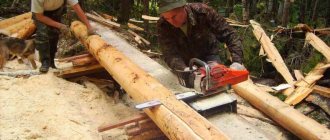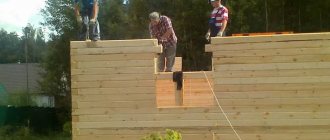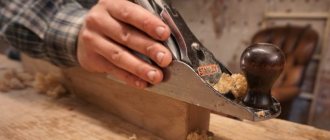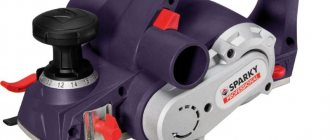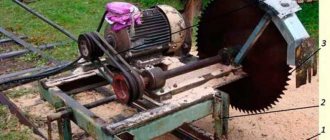When should the work be done?
When using a chainsaw intensively, sharpening is carried out quite often, often several times in one day. Particular attention should be paid to the fact that the contact of the chain with the ground significantly speeds up the process. Therefore, chainsaws must be used in such a way as to eliminate the possibility of contact between the chain and the ground. After several contacts, the chips will be very small, and the chain will go deeper into the material slightly. When considering this issue, it can be noted: the more often you have to sharpen the chainsaw chain, the less metal layer is removed. Also, if you sharpen frequently, the service life of the cutting element of the chainsaw will increase significantly. The main condition can be called the correct execution of the work, if you do it yourself. The procedure can only be performed correctly if you have a special machine. A sign that the cutting element of a hand chainsaw has become dull is a significant feed force. Properly sharpened chains determine a significant reduction in the feed force, that is, the chainsaws enter easily with a little pressure. Another sign of the need to sharpen chains is the production of very small chips. Sharpening a chainsaw when the signs in question appear is mandatory. Sharpening of chains is carried out in order to greatly reduce the tension in the body, reduce the cyclic load rate and fuel consumption. Also, if you do not sharpen the teeth of the chains on time, there is a possibility of increased wear of all components, as a result of which the service life of the hand chainsaw is reduced.
Possible consequences of poor sharpening
One of the main tasks of a chainsaw owner is to maintain the tool in optimal working condition. This also includes chain sharpening activities.
If you ignore the characteristic signs of wear, when the sharpness of the teeth has noticeably decreased, this leads to the following possible consequences:
- the cuts will turn out crooked and uneven;
- the engine and other elements experience increased load;
- inability to achieve a cut exactly along the intended contour;
- increased fuel and oil consumption;
- reducing the operational life of equipment;
- premature failure of the tire and engine.
As you can see, a poorly sharpened chain can be a reason to buy a new chainsaw. Moreover, this will have to be done against the owner’s wishes.
Geometry Features
In order to sharpen correctly with your own hands, even if you use a machine, you should know the geometry of the tooth. Its constituent elements include:
- Spatula.
- The main link.
- Depth limiter.
In this case, the tooth blade consists of the following elements:
- End blade.
- Top blade.
You need to sharpen correctly with your own hands, taking into account the fact that the end and top blades must be positioned correctly relative to each other to ensure the best cutting performance. The back of the tooth forms a certain angle of the upper blade. A similar angle is formed to cut the blades into the material. Sharpening with your own hands should also take into account the fact that the blade has a narrowing towards the back - this design feature forms the angle of the end blade. It is created to ensure lateral cutting of chips.
Chainsaw chain tooth
The sliding surface and the end part of the blade forms the rake angle. In this case, the angle has a fixed value; it varies from 60 to 85 degrees. If you sharpen the teeth with your own hands, it is worth considering that the upper blade is the main one, and the angle formed by it is the most important angle. To summarize, when considering the issue of geometry features, we note that the sharpening angle can vary depending on the conditions of use. The basic rule that should be followed when sharpening a tooth with your own hands is the following: the higher the angle, the greater the performance of the chainsaw, but reducing the value ensures smoother running of the blades, reduced vibration and increased service life. It is worth sharpening taking into account that the indicator should be in the range from 25 to 35 degrees. An exception is the version of the blade, which is intended for longitudinal cutting - many manufacturers of the chainsaw cutting element can withstand 10 degrees.
Saw design
To better understand what a chainsaw is and how it works, it is advisable to know how it works.
By the way, it would be more correct to call the cutting tool of a chainsaw a saw chain.
The first saw chains appeared at the beginning of the twentieth century. The designers did not begin to puzzle; they simply mounted teeth on the chain, which quickly lost their functionality. In appearance they resembled those that stand on hand hacksaws for wood. Sharpening such a chainsaw caused great difficulties. But repeated attempts to create the perfect saw chain were crowned with success only in 1947.
Chainsaw device
This chainsaw has links with an L-shaped cut. Modern chains are, in fact, the direct ancestors of this development.
If during work the cutting speed begins to decrease, the chainsaw in the hands of the master begins to “walk”, then most likely the saw chain has lost its operational properties, that is, it has become dull and measures must be taken to restore them.
Chain structure in a chainsaw
In fact, the circuit is quite simple.
One of its main elements are the teeth, which are located on both the left and right sides, and which alternate. They are connected to each other through other links, namely connecting ones. They are made directly from specialized steel material. In addition, the upper part of the steel is coated with a hard chrome coating, which significantly increases the service life of the chainsaw. Also important parts of the chain of this type of tool are:
- cutting link;
- side and top edges;
- depth shear limiter.
Now let's try to understand the issue regarding the reasons for the blunting of the chain itself. Why does this happen and what factors influence it? This issue is quite serious, since the productivity of the chainsaw itself depends primarily on the sharpness of the teeth on the chain. So, let's take everything in order.
feel strong vibrations from the tool while working , and notice that the tool moves slowly, then be sure that the chain on your device is dull. This is mainly caused by intensive and excessive use of the tool.
In addition, contact directly with the ground or with much harder wooden elements is important.
In addition, it is worth noting that working with such a chainsaw is highly undesirable, since this kind of negligence can lead to significant problems. Among which are not only significantly high fuel consumption and very slow cutting, but also vibrations directly on the body, and this, in turn, leads to breakage of the sprocket and even the tire itself.
Why does the tool become dull?
Each chainsaw has a certain durability period. This is the time from the start of work with a new tool until it becomes inoperable.
Destruction or wear of a cutting tool intended for woodworking occurs due to the impact of a set of forces arising during the cutting process. One of the key ones is friction force. Dulling of the saw chain occurs due to prolonged work, due to the use of a chainsaw for purposes other than its intended purpose.
The amount of wear can be defined as a measure of weight, measured in milligrams. Wear is a parameter that shows a change in the characteristics of the shape and size of the cutting blade. The change in geometric parameters that occurs during cutting, and there is no linear wear, is called blunting.
There are parameters on the basis of which a decision is made about the possibility of further operation of the tool. In particular, when examining the teeth of a saw chain, it is necessary to pay attention to the edges of the front and rear surfaces, the height of the blade, and the wear area. If they are in unsatisfactory condition, it means it’s time to sharpen the chainsaw.
Signs that the saw has lost its sharpness include the following:
- Reducing chip size.
- Using more force to do the job.
Signs of a dull chainsaw chain
- Increased physical effort when cutting down a tree.
- Stretching of the chainsaw chain, which was previously uncharacteristic.
- Vibration when cutting or chainsaw braking.
- Lack of cutting accuracy, the chips become uneven, with sharp edges and jagged edges.
- There is rust on the chain, the steely sheen of the metal is missing.
The use of low-quality oil, as well as incorrect adjustment of the chain (must be strictly in the grooves) also cause early dulling of the teeth.
When to sharpen and how to find out about it
After examining the saw chain, the master decides whether it is time to sharpen the tool or not.
As a rule, the saw chain loses its performance properties during intensive work. It can get to the point where the chain will have to be sharpened several times in one day. The cause may also be contact of the saw with the ground. In fact, just scrape the saw chain across the ground a few times and you can stop all work. The chainsaw will simply stop going into the tree. By the way, one of the signs of a dull saw is the appearance of small chips.
Dull chainsaw chain
The sooner measures are taken to sharpen the chain, the longer it will last. It is quite easy to understand when resharpening is required. There will be a feed change. A chain with properly sharpened teeth will retract even with a small force, but if during operation you have to exert a greater feeding force, then this means only one thing, the teeth have lost their sharpness.
Do not use a blunt chain. By the way, this is a safety requirement. And the process will require significant muscular effort from the lumberjack. As a result, this leads to a decrease in cut quality, an increase in the amount of fuel used and accelerated chain wear.
Benefits of sharpening a chain with a file
- The service life of the chain is significantly increased.
- There is no risk of ruining it.
- Editing can be done anywhere, wherever you are, regardless of the availability of electricity.
For sharpening chainsaws on construction sites, as well as in places where wood sawing is carried out, it is most convenient to use a file. Thanks to the presence of numerous devices to facilitate the process, even a person with no experience can straighten the chain; the main thing is to remember safety precautions when working with a chainsaw and follow the recommendations received in the article.
File
A file can be used to carry out the work in question. A file is used to remove the required layer of metal from the surface. A special set was created for this case:
- The file is round and has an unusual holder.
- Flat file needed to adjust the depth limit.
- Hook.
- Special template.
The round file holder is created along with marking lines that are used to position the tool correctly. During operation, the plate itself comes into contact with the depth stop and the surface of the blades, and the file moves around and removes a layer of metal. The use of a special holder with a file allows you to ensure the correct fit of the tools to the surface being processed. You should only use a file that is designed to perform such work.
Angles of inclination when sharpening with a file
The rules of work include:
- The same number of movements should be done.
- It is necessary to control the force of pressure on the surface during processing.
- The template, which is used together with the file, allows you to maintain important sharpening parameters.
With different lengths, uneven travel and the formation of cracks in the material are observed. If the length indicator is not the same at the start of processing, then all cutting teeth are filed according to the indicator of the smallest one.
Application of special machines
It is not always possible to use a hand tool with a template. For example, if the cutting edge comes into contact with the ground during operation, there is a possibility of its deformation. In this situation, a special machine is used. The machine comes in two types:
- Mechanical.
- Electric.
The power saw has a design that looks like a bow saw, but with a round file. The machine can be used to level the length of all edges and restore the correct geometry. The machine in question has a complex system for setting processing parameters. Sharpening is performed in approximately 2-3 movements, after which the machine is installed in a new location.
The electric machine is easy to use. A special adjustment system allows you to correctly position the surface to be treated, as well as position the disc with high accuracy. Some models have an automatic vice clamping system when the disk is lowered. The cost of the electric version is slightly higher, but at the same time the performance increases significantly and the most accurate result can be achieved.
PDF Guide to Sharpening Stihl Saw Chains
Sharpening with files
Files are an excellent hand tool option that can be used to restore the sharpness of teeth.
When using them, it is important to remember to maintain the sharpening angle of chainsaw chains.
But it would still be right to start with another question. It concerns how to choose the right file for sharpening a chainsaw chain.
The selection of tools largely determines the quality of future work performed. If you choose the wrong file, then at best the efficiency of the teeth will drop even lower. At worst, you will damage the chain so much that it will no longer be possible to restore it.
To sharpen a chainsaw chain with a file, focus on the pitch of the chain teeth.
The most popular tools have a step:
- 1/4;
- 0,325;
- 3/8;
- 0,404.
Accordingly, files of the following diameter are suitable for them:
- 4,0;
- 4,8;
- 5,2;
- 5.5 millimeters.
There are rarer exclusive saw chains. They will require a cylindrical analogue with a diameter of 3.2 millimeters.
For comfortable work, it is worth using tools measuring 200 mm.
Sharpening technology
It is recommended to sharpen a chainsaw chain correctly with a round and flat file.
In general, for work you should prepare the following kit:
- round file;
- flat sharpening tool;
- holders;
- machine for teeth.
Using a round file, you will process the edges on saw teeth, which have a rounded shape. Mostly hand tools with a diameter of 4 to 5.5 millimeters are used.
A flat tool is needed to sharpen the depth stops. After all, the ability of the chain to eat or bite into the structure of the material being processed depends on them. It's mostly wood. But chainsaws can be used for cutting and cutting other materials.
The proper sharpening of a worn chainsaw chain involves carrying out the work without removing the element from the structure of the tool. In this case, the saw should be placed on a flat horizontal surface. Make sure the brake is on first.
Before sharpening, you need to carefully inspect the chain along its entire length. It is possible that cracks, chips or breaks have formed there. Some defects turn out to be so serious that sharpening such a chain is pointless.
In the process of returning sharpness to the teeth of a chainsaw chain, you need to take into account the following technology features:
- the teeth should be sharpened strictly from the inside out;
- the degree of sharpening depends on the marks applied by the chain manufacturer;
- The tooth that is being sharpened must be positioned in the middle.
Such work, carried out manually, necessarily involves the use of thick protective gloves, as well as a mask and goggles. Otherwise, you may cut yourself on the teeth or be injured by flying metal shavings.
The master can greatly simplify his task. But for this you will need to buy a special holder designed for sharpening. But with its help you can clearly select the depth of the stopper and select the correct angle for sharpening.
The straightening machine (with emphasis on I) is attached to the tire using clamps. Next, the guides are set at an angle, and through them the degree of sharpening is determined.
The tooth that is being processed must be fixed with a stop. A file is installed on top of it.
Regardless of the equipment used, you first need to sharpen the edges and only then align the depth stops.
Step by step process
The sharpening process, where the file plays the main role, is performed in the following sequence:
- the saw is fixed for better and more precise processing;
- holders are mounted based on the scale readings;
- The sharpening angle is determined by raising the holder 1/5 above the tip;
- The minimum turning size is determined by the bluntest teeth;
- processing is carried out using a round file;
- it is important to make smooth movements from yourself;
- 2-3 smooth movements for each tooth.
Be sure to turn the file over during the sharpening process. This is necessary in order to avoid uneven stitching.
It is also important to sharpen the teeth on both sides. Only after finishing the first side can the chainsaw be turned over.
A good solution would be to install a template for the limiter. The index part is located between the teeth. The protrusion that forms above the template will need to be filed off with a flat file.
How to properly sharpen a chainsaw chain with your own hands. Step-by-step instruction
Bringing a chain into working condition has its own characteristics. They are determined by the configuration of the tooth. It includes two edges, located - one at the top and the other at the bottom. Moreover, the edge located towards the top has a slope at a given angle. In fact, the tooth, both in geometry and in its operating principle, is similar to the blade of a carpenter’s plane.
Manual chain sharpening diagram
For competent sharpening, the master must understand the structure of the tooth.
Teeth parameters
The tooth structure consists of:
- grounds;
- shoulder blades;
- limiter.
Two cutting edges are formed on the blade, one is placed on a horizontal plane, the other at an angle. To obtain the required parameters, the blades are sharpened at the angle specified in the technical specifications. The rake angle is sharpened in the range from 60 to 85 °.
The clearance angle indicates the backward tilt of the upper blade. It lies in the range of 50 to 60°. The blade located on top is considered the main one; the rear angle in this design is very important. It is difficult to measure; if the sharpening rules are followed and the geometric parameters are observed, it is formed in the specified range.
Teeth
The corners are sharpened depending on the use of the tool. The main rule is that the larger the angle, the greater the efficiency when processing soft wood; the smaller the angle, the easier it is to operate the saw with hard wood. That is, the smoothness of operation improves and the vibration of the tool decreases.
Meanwhile, the situation of sharpening the angle greater than 35 and less than 25° should be avoided. This rule does not apply to rip chains.
The angles change when editing the tool. They have an important impact on cutting parameters, so all technical requirements must be carefully followed.
Chainsaw chain sharpening angle. How to choose the right one?
Even the popular Stihl does not last forever: the teeth of a chainsaw eventually wear out, which is easy to determine by the nature of the chips that form. With a dull cutting edge, the chips turn out to be small, because the working edge does not cut, but crushes the wood. Naturally, the effort expended by the operator increases sharply. It's time to sharpen the saw. How to do this correctly - choose the optimal technology, determine what angle of tooth sharpening should be and how to check it?
External signs of a dull cutting edge of a chainsaw tooth
Let us recall that a chainsaw tooth has a complex configuration (see Fig. 1), which also depends on the direction of movement of the chain.
It has two working edges: a side edge, which is located perpendicular to the axis of movement of the links, and an upper edge, located at a certain angle to the direction of movement of the chain. In addition, a limiter is provided on each tooth, the parameters of which determine the height of the chips removed.
Since the main cutting force falls precisely on the working angle, all subsequent work with the tool will depend on the angle to which the tooth is sharpened.
Figure 1 – Functional parts of a chainsaw tooth and their appearance
Before starting long-term work with a chainsaw, it needs to be inspected and test sawed, as a result of which:
- Visually determine the presence (or absence) of a conical section adjacent to the corner of the tooth, as well as a radius rounding on it - the main signs of blunting (see Fig. 2).
Figure 2
- Check the feed force at which the tool operates steadily and produces a quick cut. For sharp teeth, the initial moment of penetration of the tooth into the wood occurs quickly, and without significant resistance to the material.
- Find out the presence of chain vibrations during a steady cut - if they are noticeable, then the teeth need to be sharpened.
- Inspect the appearance of the newly cut end (especially if the tool is used for rip sawing). If there are rough chips and dents, the chainsaw chain must be sharpened.
Sharpening angles and chainsaw tooth configuration
The cutting edge of a tooth is characterized by the following parameters:
- Width;
- Thickness;
- Sharpening angle.
In addition, each tool model has its own tooth pitch, the value of which for household and semi-professional models is associated with the power of the chainsaw and the torque that the drive develops.
For example, for rip sawing, the pitch is taken smaller (for example, 0.325 inches). In this case, work productivity will decrease, but the required force will be significantly lower.
Upper step values for household chainsaws are adopted extremely rarely, mainly when felling trees with a large trunk diameter. The engine power should not exceed 2500 W.
The thickness of the cutting edge of most chainsaw manufacturers is set to the same, and equal to 1.3 mm (there are also edges with a thickness of 1.1 mm, but, firstly, they are extremely difficult to sharpen at home, and, secondly, such links are extremely have little functionality: they can only be used for cutting thin branches).
The height of the chain profile can be either 0.625 mm or 0.762 mm, and in the vast majority of cases, a low profile is used for household gasoline tools. When sharpening limiters, this parameter is very important, because as the height of the excess permissible values decreases, the vibration of the tool during operation increases, although the quality of the cut remains satisfactory. Therefore, you should not get carried away with reducing the height of the stop when sharpening a tooth.
The sharpening angle of a chainsaw chain depends on the main purpose of the tool - for transverse or longitudinal sawing. Since during longitudinal sawing the resistance of wood is always noticeably higher, the edge of the tooth must be very sharp.
It is recommended to do it in the range of 6...12° (for comparison - with a predominance of cross cuts - up to 25...30°). Naturally, in the first case, sharpening should be done more often, and especially carefully, since an unacceptably small angle of inclination of the tooth contributes to its rapid chipping when using a chainsaw.
This is especially important for links that are made from structural alloy steels containing silicon and manganese, for example, 40ХГС or 35ХГСА.
Chainsaw chain sharpening template
When purchasing a chainsaw, it is advisable to acquire a special template (see Fig. 3), with which you can easily set the optimal values of the tooth angles. It is used to control the values of the rear angles of the upper and end blades, as well as the front edge angle (it is indicated in the manufacturer’s instructions and can vary within 65...80°).
It is especially important to use a template to estimate the clearance angle of the upper blade. This sharpening angle of a chainsaw chain is otherwise very difficult to determine, and yet it must be maintained within rather limited limits - from 50 to 60°.
The sharpening angle is measured by determining the angle between the top cutting edge and a line perpendicular to the chain guide.
The sharpening angle of the chainsaw chain can be changed, depending on what work will be done. As the hardness of the wood increases, its value should decrease. In general, the optimal angle value is 10...12° for longitudinal cutting, and 25...30° for cross cutting.
Figure 3 – Appearance of a template for sharpening chainsaw teeth
Sharpening can be done manually using a round file with a working diameter of 4...5.5 mm, or on a machine. In the first case, it is extremely important to correctly position the tool relative to the tooth being sharpened. The upper edge of the working part of the file is located approximately a fifth above the upper edge of the tooth. The tool is positioned perpendicular to the chain axis, and at an angle of 25...30° to the upper edge of the tooth
One round file is not enough. To sharpen the limiter, you will need a flat file, and to clean the work area, you will need a hook that removes the sawdust that forms.
There are also special holders on sale, on which the lines of direction of movement of the file relative to the chain axis are graduated. As can be seen from Fig. 4, the holder can be installed on the tooth from above, and rest on its upper edge.
Since the height of the holder is adapted to a certain chain pitch, it should be selected in relation to chainsaws of specific models and brands.
The minimum required set to obtain the correct angle for sharpening a chain manually is shown in Fig. 5.
Figure 5 – Set of sharpening tools and accessories
First, the teeth of one direction are sharpened, and then the other. Start by lightly pressing the tool away from you, gradually increasing the load. During sharpening, the round file is periodically rotated along its axis.
Mechanized sharpening on a machine
Sharpening on a machine is much more convenient and does not require highly qualified performers. Such machines are electrically driven and equipped with special grinding wheels.
For a household workshop, it is worth purchasing compact units that do not take up much storage space and are suitable for quick and high-quality sharpening of chainsaw chains from different manufacturers. Such units should operate from a stationary power supply with a voltage of 220 V, have low power consumption (up to 100 W) and be easy to install on the circuit.
When choosing a machine, you need to pay attention to the following technological characteristics:
- Possibility of processing teeth with different thicknesses of the upper edge and different chain pitches;
- The ability to adjust the sharpening angle, within the limits specified earlier;
- Availability of replaceable grinding discs;
- Constant value of the cutting width.
Tips and tricks on how to sharpen a chainsaw at home
It is permissible to use a file for sharpening, but you must understand that such operation of the saw will require certain skills and, of course, patience from the master. To sharpen each tooth, you need to have flat and round needle files on hand. To sharpen a tooth, without using additional equipment, it is necessary to maintain the basic sharpening inclination. Only 2-3 passes with a file are enough for sharpening, so there is no point in inventing some kind of equipment to fix the tooth in a certain position. To sharpen the top edge, the file must be held at the required angle while working. Restoring operability begins with preparation, namely, from the working edges; it is necessary to remove all nicks.
If everything is clear with the angles of the teeth with straight parts of the structure, then the edge located on the side and its working inclination cause certain difficulties. To straighten them, you need to use a round file or a small file. These tooth elements are sharpened at the required angle.
Using the machine
Experts agree that it is better to use a special electric machine for sharpening chainsaw chains. With its help you can achieve factory accuracy.
To learn how to properly sharpen the chain from your chainsaw on a machine, you need to perform the following steps:
- the saw should be installed in a special hole;
- loosen the flail clamp screw;
- adjust the level of sharpening based on the table or the state of the bluntest tooth;
- sequentially process one tooth after another, changing the polarity on the machine;
- or process the teeth one at a time (right, then left) so as not to change the polarity;
- Upon completion of the procedure, treat the chainsaw with machine oil.
That's it, the procedure is completed. Minimum time and maximum accuracy.
Sharpening on a machine
If sharpening work is carried out quite often, then it is necessary to use special equipment and technological equipment (templates). Using a template on a device of this type allows you to complete this work much faster. Such a device can be a wooden block of small size. This type of template should allow sharpening at two angles. Sharpening can be done using a small diameter grinding wheel or an emery belt that can be mounted in place of the belt drive.
Chainsaw chain sharpening machine
Sharpening a chainsaw chain with a machine
Machines of this type, masters, can be made independently, using the drive from a foot-operated sewing machine as the basis for the design. Using a belt drive and a template, it is possible to process one cutting edge and then another.
How to sharpen with a grinder
Now to the question of how to sharpen a chain with a grinder on a chainsaw. A fairly common option, but still has its own characteristics.
In general, sharpening a chainsaw chain, done with your own hands using a power tool in the form of an angle grinder, is not an easy task. The reason is that here you need to be extremely careful and precise. No limiters are used. Hence this feature.
First, the grinder should be fixed using a workbench or table. It is advisable to have a reliable clamp at your disposal. After fixing, check whether the power tool vibrates excessively. If there are vibrations, then the structure will have to be strengthened further.
The sharpening technology requires passing the teeth along an abrasive wheel installed on the grinder.
The danger of this method is that the shaft with the grinding disk (circle) rotates very quickly. The load is transferred to the chain. Inaccurate movement can lead to injury to the technician. Therefore, be extremely careful.
A grinder used as a sharpening tool has several weight disadvantages:
- it is difficult to control the thickness of the layer being removed, and everything depends on the accuracy of the master;
- when sharpening with a grinder, mistakes are made much more often compared to a file;
- If you are careless, you can cut off the connecting ears that hold the links.
In addition to fixing the grinder on a machine or table, you can use an alternative method. In this case, the chain is fixed motionless, and a grinder held in the hands is brought to it. But usually the accuracy of sharpening decreases even more.
Now you know how to sharpen a chainsaw chain with a grinder.
Technical features of the sharpening process
The sharpening operation is complicated by the fact that the teeth have a large number of cutting edges located in different planes and having different sharpening angles. When sharpening teeth, it is necessary to make the same amount of movement, and it is necessary to withstand the same pressure force. As a result, all teeth will receive the same type of sharpening.
Also, if the saw chain is sharpened more than 4 or 5 times, then the depth stop must be reduced.
How to know when it's time to sharpen your chain
You can understand that it’s time to sharpen the chain by characteristic signs, such as the uncontrollability of the tool, which constantly gets stuck in the wood and the appearance of dust instead of traditional shavings. Also indicating a decrease in the sharpness of the teeth is a difficult recess and the need to make serious efforts to saw the wood, which happens extremely slowly. However, you can see that the chain needs sharpening by a number of external signs that are observed during visual inspection:
- blunt edges;
- rust;
- no steely shine.
